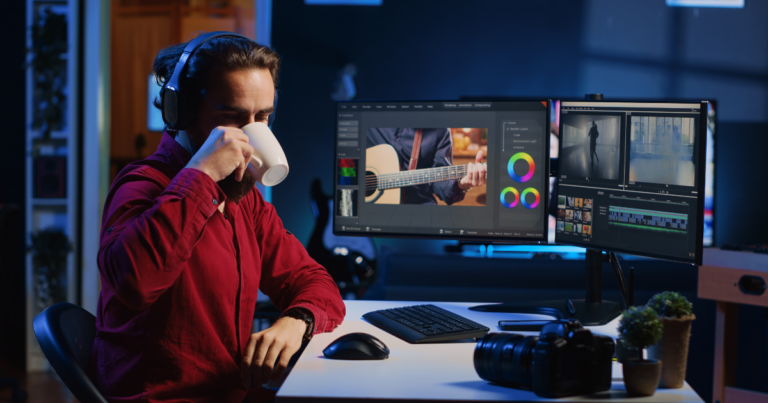Overview
Turning still photos into dynamic, engaging videos has never been easier. Thanks to advancements in artificial intelligence, creators can now animate images, add transitions, music, and effects, all within minutes. These tools are perfect for marketers, social media creators, businesses, and anyone looking to tell a story visually.
In this blog, we’ll explore the 10 best AI photo to video tools in 2025. Each tool comes with unique features, benefits, and limitations, so you can choose the one that best fits your needs.
1. Invideo AI
Invideo AI is one of the most popular AI-powered platforms that allows you to instantly turn your photos into professional-quality videos. Whether you’re creating social media posts, marketing content, or personal slideshows, Invideo AI makes the process fast and intuitive.
Features:
- AI-driven templates for various industries.
- Drag-and-drop photo-to-video editing.
- Vast stock library for images, videos, and music.
- Automatic text-to-video generation.
Pros:
- Beginner-friendly interface.
- Wide range of templates and assets.
- Fast rendering and easy exports.
Cons:
- Advanced customization may require some learning.
- Limited offline usage since it’s web-based.
2. Animoto
Animoto is a long-standing video creation tool that lets you transform photos into engaging videos with AI-assisted editing. Its focus is on simplicity, making it great for business presentations or quick social media content.
Features:
- Drag-and-drop video builder.
- Pre-built templates for different purposes.
- AI-powered music syncing.
Pros:
- Easy to use for beginners.
- Great for social media marketing.
Cons:
- Limited advanced editing features.
- Fewer customization options compared to other tools.
3. Pictory AI
Pictory AI is designed for content creators who want to convert images or scripts into short, engaging videos. It leverages AI to automatically add captions, background music, and transitions.
Features:
- Text-to-video and photo-to-video capabilities.
- Automatic caption generation.
- Built-in stock footage and audio.
Pros:
- Time-saving automation.
- Great for YouTube and social media videos.
Cons:
- Watermark on free plan.
- Some templates feel limited.
4. Kapwing
Kapwing is a popular online editor that supports ai picture to video transformations along with powerful collaboration tools. It’s especially useful for teams working on projects together.
Features:
- AI tools for automatic resizing and background removal.
- Supports GIFs, photos, and video creation.
- Real-time collaboration.
Pros:
- Excellent for team projects.
- Supports multiple file formats.
Cons:
- Free plan has export limitations.
- Can lag with large files.
5. FlexClip
FlexClip is a versatile online editor that lets you create photo-based videos with AI assistance. It comes with templates and effects designed for quick storytelling.
Features:
- AI-driven storyboard editor.
- Extensive stock library.
- Animated text and overlays.
Pros:
- Quick and simple editing process.
- Great template variety.
Cons:
- Export resolution limited on free plan.
- Some templates look generic.
6. Animaker
Animaker is an AI-powered platform that focuses on animated and explainer videos, but it also has strong photo-to-video features. It’s a great choice for businesses that need polished visuals.
Features:
- AI animation and transitions.
- Library of animated characters and icons.
- Photo-to-slideshow conversion.
Pros:
- Professional-looking results.
- Wide customization options.
Cons:
- Interface can feel complex for beginners.
- Export time can be slow.
7. Pixgram
Pixgram is a mobile-first photo-to-video maker, ideal for quick social media content. It allows you to combine photos, filters, and music directly from your phone.
Features:
- Easy photo upload and slideshow creation.
- Music integration from your device.
- Simple filters and effects.
Pros:
- Lightweight and mobile-friendly.
- Perfect for casual creators.
Cons:
- Limited advanced editing.
- Mostly designed for quick posts.
8. VivaVideo
VivaVideo is another mobile-based video creator that blends AI automation with manual editing. It’s widely used by influencers for TikTok, Instagram Reels, and YouTube Shorts.
Features:
- Built-in transitions, filters, and effects.
- Photo-to-video slideshow creator.
- Rich library of music and sound effects.
Pros:
- Great for social media.
- Easy to use with powerful mobile editing tools.
Cons:
- Free plan has heavy watermarking.
- Contains ads on mobile.
9. Kizoa
Kizoa is an online video editor that allows you to animate photos with AI effects and transitions. It’s especially useful for creating educational or event-based videos.
Features:
- Slideshow maker with transitions.
- Music and text overlay options.
- Online sharing and embedding.
Pros:
- Easy to share videos.
- Simple and intuitive.
Cons:
- Limited modern templates.
- Not as advanced as newer tools.
10. Quik by GoPro
Quik is designed for GoPro users but works just as well for anyone wanting to turn photos into videos. It uses AI to sync transitions with the beat of your music.
Features:
- Automatic photo-to-video editing.
- Beat-synced transitions.
- Cloud storage for media.
Pros:
- Quick and fun editing process.
- Great for adventure and lifestyle videos.
Cons:
- Limited desktop support.
- Mostly designed for mobile users.
Final Thoughts
AI-powered tools are revolutionizing the way we create videos from photos. Whether you’re making content for business, social media, or personal use, these platforms make it easy to animate images and add a professional touch. If you’re looking for powerful video making apps like Invideo AI, you’ll find that these tools save both time and effort while delivering high-quality results.




